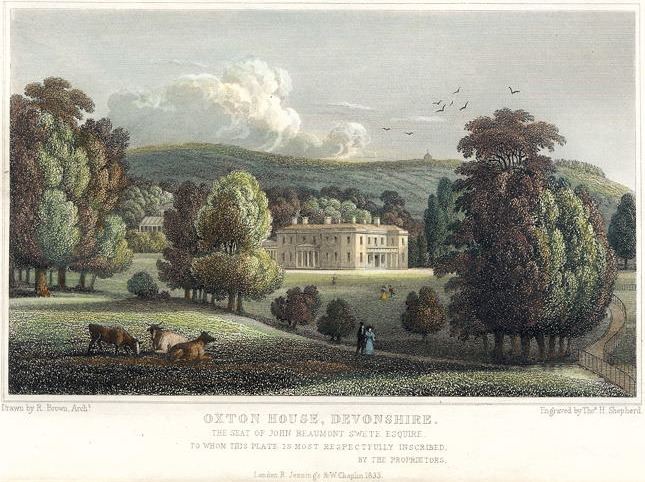 | ||
Oxton in the parish of Kenton in South Devon is a historic estate long held by the Martyn family, a junior branch of the Norman family of FitzMartin, feudal barons of Barnstaple.
Contents
Oxton House is a Grade II listed building. The park and gardens are Grade II listed in the National Register of Historic Parks and Gardens.
Features
Martyn
The later descent of Martyn of Oxton is as follows:
Tripe/Swete
Studd
In 1848 Oxton was purchased by Lt. General Edward Mortlock Studd (1799 - 6 December 1877), of Oxton, J.P. and Deputy Lieutenant for Devon, Sheriff of Devon in 1862, whose large chest tomb survives in Kenton Church graveyard. He was the eldest son of Edward Studd (d.1813), descended from the 14th century family of Studd (alias Stote) of Drinkstone in Suffolk, an officer of the East India Company. Edward Mortlock Studd married secondly Emma Beatrice Bayly, daughter of Lt. Charlton Booth Bayly, Royal Navy, of Sidmouth, Devon, by whom he had a son and heir Edward Fairfax Studd (1855-1942), of Oxton, a barrister, JP and Captain in the Royal Field Artillery, who married Evelyn Chichester (born 1854), 3rd daughter of Sir Arthur Chichester, 8th Baronet, Colonel of the North Devon Yeomanry Cavalry, of Youlston Park, Sherwell, North Devon. He also resided nearby at Exleigh, Starcross, Devon. The Lt. General's 2nd son was Alnod Ernest Studd (1857-1906), a distinguished chess player, who after a brief military career in the 15th Hussars (1875-9) became bankrupt in 1901 through speculation on the Stock Exchange in 1882 and from a failed investment in 1891 in a coffee estate at Bundara, Mysore, India. The Studd family owned Oxton until about 1915, when it was sold to Joshua John Neale.
Neale
Joshua John Neale purchased Oxton in about 1915. He was a fish merchant and ship owner of Irish origin who in 1885 together with Henry West founded a fishmongery business in Custom House Street, Cardiff. In 1888 with West he established the Neale & West Trawler Co. In 1899 he resided at Park Road, Penarth, Glamorgan. On 6 February 1899 a steamship he half-owned named "Ramsey", registered at Cardiff, was stranded and lost on the Wolves Rocks in the Bristol Channel. In 1920 "Joshua John Neale of Oxton, Kenton, near Exeter" was listed as a County Magistrate for Dinas Powis Petty Sessional Division, in Glamorgan, Wales. He was a student of archaeology and a naturalist and was author of "The Birds of Ireland", written before 1902 and gave a speech in Cardiff in 1917 entitled "The Survival of the Unfittest". He was a close friend of Robert Drane (d.1914), a pharmacist from Swansea who was a founding member of the Cardiff Naturalists Society in 1867, and at sometime its president, who discovered the Skomer Vole, was an authority on porcelain and was honorary curator of Cardiff Museum. A 1913 photograph of Neale and Drane exists in the Glamorgan Archives, together with correspondence between the two men. More than 100 photographs of Oxton House and grounds at this time survive in the Neale family papers.
Hare
In about 1925 Oxton was purchased by Richard Granville Hare, 4th Earl of Listowel (1866–1931), whose father the 3rd Earl had died in 1924.
Later history
From 1938 to 1966 Oxton was used as Bletchington House School, a girls' boarding school.
The house was sold in 1966 and then divided into apartments for multiple occupancy.
